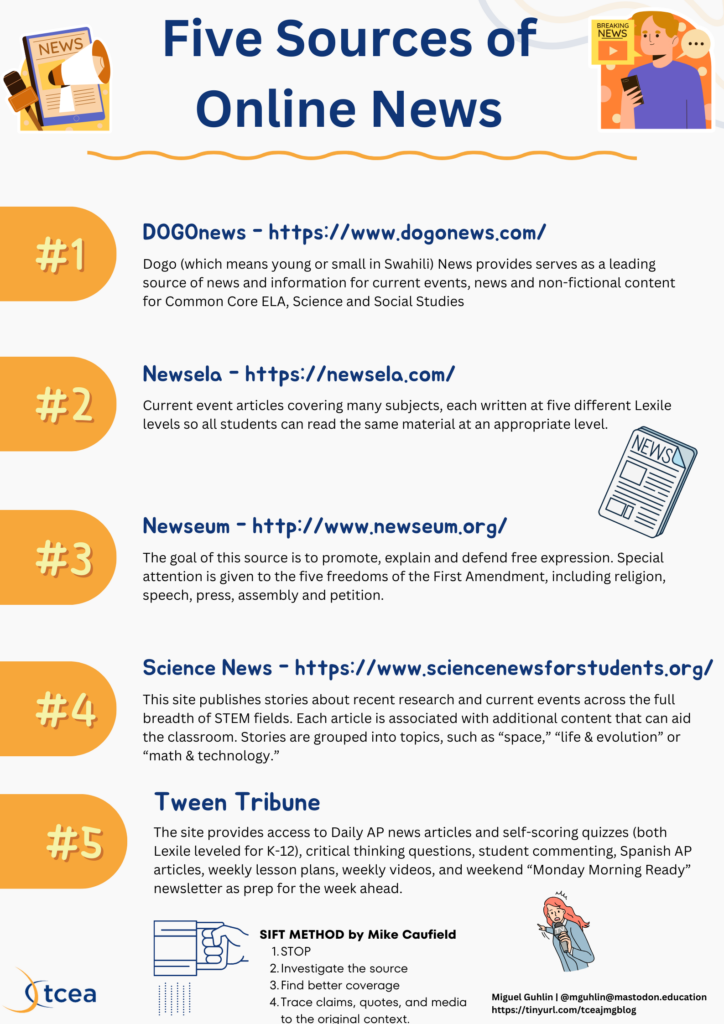“Oh my goodness, have you seen all the political ads on the television recently?” said a colleague earlier this month. It’s an election year, but how are you making sense of what’s true and false? Many of us have to learn how to deal with persuasive text, which may include political propaganda. And many adults and students are dealing with media overwhelm.
The middle school Texas ELA TEKS emphasize critical thinking skills. But how do you teach that? Let’s take a look at one approach you might consider. That approach is Mike Caufield’s SIFT Method (CC-BY 4.0 license). Before jumping into an overview of SIFT, let’s take a moment to review why it’s even necessary.
Media Overwhelm
If you can read, listen, or watch content, you are under continuous assault. Differing viewpoints and perspectives assail your senses. In fact, when you have so many points of view, you may lack an easy way to make your own selections. The sheer volume of content can force some to throw up their hands in anomie.
Did You Know?
Anomie is an old concept, dating back to Emile Durkheim’s 1897 work, “Suicide: A Study in Sociology.” You may, as I did, have first learned about it in high school sociology class. Anomie occurs when the norms and values of society are unclear. People become confused about how to behave. Social order is threatened and people feel unrestricted in their behavior.
Anomie is a lack of rules about interpreting content resulting from the media blizzard. It raises its head with media due to the effects of media overwhelm. This can have dire consequences for students:
The psychological and social effects of excessive exposure to media and information can lead to feelings of isolation or conformity.
Hyper-connectedness results in feelings of disconnection that can affect students (source). To assist students and staff, you might consider adopting a tool to sift through the fluff.
Introducing SIFT
A simple process, SIFT is an acronym that represents the following actions:
- Stop. Check your emotions. If you have an emotional response to content, you’ve been “hooked” already.
- Investigate the source. Where does the content originate? Who made it?
- Find better coverage. Check other reliable sources to verify.
- Trace claims, quotes, and media to the original context.
Each step in the process comes with a few moves and questions you can ask. You can find these outlined in the infographic below.

View | Get a Copy in Canva | Get PPTx or PDF
Using the SIFT approach (or SIFT Method) in a real-life situation is easy. Let’s give it a go.
Example Use of SIFT Method
“Hey, Miguel, did you hear the news? Our principal now expects us to write all our lesson plans by hand to prove they weren’t generated by AI.” said a teacher at a recent event. “It’s in response to a new policy that goes something like this,” she shared. Then she gave me a printout:

View full size | Get a Copy in Canva | Get PDF (Adapted from Jason Horne’s “What do you tell teachers about AI?“)
What might this analysis look like with the SIFT Approach in mind?
| SIFT Step | Questions to Ask | Moves | Analysis |
|---|---|---|---|
| S – Stop | – What is my initial reaction to the memo? – What do I know about the source of the memo? | Pause and consider any immediate reactions. Reflect on the credibility of the source. | The memo is formal and appears to be from a school principal, Juan Wright, addressing the teaching staff. It seems to be a legitimate communication about policy regarding the use of Language Learning Models (LLMs). |
| I – Investigate the Source | – Who is Juan Wright? – What is the reputation of the school or institution? | Research the author and the institution to understand their credibility. | Juan Wright is identified as the principal. To further investigate, one would need to look up his professional background and the school’s reputation. However, this information is not provided in the memo or the search results. |
| F – Find Better Coverage | – Are there other documents or announcements from the school that discuss the use of LLMs? – Have other schools implemented similar policies? | Look for corroborating documents or policies from other sources. | The memo itself does not provide other sources, but one could search for similar policies at other educational institutions or official guidelines on the use of AI in education to compare practices. |
| T – Trace Claims, Quotes, and Media to their Original Context | – Can the policy points mentioned in the memo be traced to educational standards or guidelines? – Is the policy based on research or recommendations from educational authorities? | Seek out the original sources that may have informed the policy. | The memo does not cite specific research or educational standards. To fully trace the policy’s basis, one would need to access the school’s official policy documents or inquire with the administration about the research or guidelines that informed the policy. |
Applying the SIFT Method
Now that you know what SIFT is, let’s apply it quickly to a news item, “Artificial Intelligence Helps Complete Beethoven’s Unfinished Symphony” from DoGoNews. The analysis below relies on ChatGPT-generated content:
| SIFT Step | Questions to Ask | Moves | Analysis |
|---|---|---|---|
| S – Stop | – What is my initial reaction to the headline? – What do I already know about the topic? – What do I know about the source? | Before diving into the content, pause to consider any biases or emotional reactions. Reflect on the source’s credibility. | The headline is intriguing and might evoke curiosity or skepticism. Given that DoGoNews is a platform aimed at younger audiences, it’s designed to be educational. However, it’s still important to approach with a critical mind. |
| I – Investigate the Source | – Who is the author? – What is the mission of DoGoNews? – Are there any potential biases? | Research the author and the publication to understand their credibility and potential biases. | Lisa Castillo, the author, writes for DoGoNews, a site dedicated to providing news for kids. While the site aims to educate, it’s crucial to cross-check information with other reputable sources to ensure accuracy and lack of bias. |
| F – Find Better Coverage | – Are other reputable sources reporting on this? – Do fact-checkers support the claims made? | Look for corroborating or contradicting reports from other sources. | The completion of Beethoven’s unfinished symphony by AI is covered by multiple reputable sources, including CBC[3], NVIDIA Blog[5], and Classic FM[6]. This widespread coverage by credible sources supports the article’s claims. |
| T – Trace Claims, Quotes, and Media to their Original Context | – Can the original studies or announcements be found? – Is the information presented in its true context? | Seek out the original sources of claims, quotes, and media mentioned to verify their accuracy and context. | The article references resources like Theconversation.com, NPR.com, and ScientificAmerican.com[1], which are reputable. However, directly accessing these sources or looking for the original announcements or studies would provide the most accurate context and information. |
Looking for some additional sources of age-appropriate news? Here’s a short list:

View full-size | Get a copy in Canva or PDF
Now that you’ve seen it in action with age-appropriate content, let’s look at a lesson plan using the same example.
Lesson Plan Example
In the example below, you will see the following:
This lesson plan aims to teach 6th graders how to think in a critical manner. It also facilitates their understanding of how to assess online sources. This aligns to the relevant TEKS standards for English/Language Arts. The activities build on one another, solidifying the SIFT method’s learning goals. Accommodations appear to ensure all students can engage and gain from the lesson.
Here’s what a 60-minute lesson plan for sixth graders might look like:
| Objectives | Standards | Pre-Assessment | Activities | Post-Assessment | Accommodations | Time |
|---|---|---|---|---|---|---|
| TEKS ELA.6.12.H.i: The student uses critical inquiry to analyze the author’s choices and how they influence and communicate meaning within a variety of texts. | TEKS ELA.6.12.H.i: The student uses critical inquiry to analyze the authors’ choices and how they influence and communicate meaning within a variety of texts. | Students will complete a short quiz to assess their initial understanding of evaluating sources and identifying credible information. | Introduction to SIFT (15 mins): Briefly explain the SIFT method and its importance. Use a simple, clear example to illustrate each step. Group Activity (20 mins): In groups, students will apply the SIFT method to pre-selected websites or articles. Each group will present their findings. SIFT Practice (20 mins): Students will individually choose an online article and apply the SIFT method, documenting their process and conclusions. | Students will write a brief reflection on how the SIFT method changed their perspective on evaluating sources and how they plan to use it in the future. | Provide visual aids and step-by-step guides for each SIFT step. Offer additional time for tasks as needed. Use technology to assist students with special needs. | 60 mins |
In a world flooded with media, telling the truth from falsities is essential. Equip your students with a critical thinking approach, the SIFT method—stop, investigate the source, find better coverage, and trace claims back to their roots. It will assist them in sorting through the noise to evaluate media with a critical lens. This approach will guide you through the firehose of content and help you avoid the confusion and disconnection that too much information can cause.

